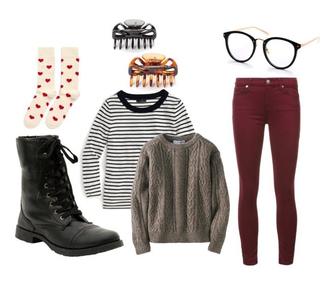|
10/17/2016 6 Comments What to wear to lab: Fall edition
By Rita Algorri
During my time as an “official laboratory safety enforcer,” (aka lowly lab tech in charge of wrangling undergrads and throwing improperly dressed folks out of lab), spring and summer notoriously brought tons of dress code related drama into our laboratories. Crop tops, flip-flops, short skirts, destroyed denim, shorts, and arguments that began with an assertive, “I swear these are actually shoes,” were all too commonplace. Wearing nitrile gloves or plastic grocery bags on your feet (true story) is unflattering, dangerous, and attracts the unwanted attention of the health and safety inspector who is side-eyeing your lack of shoe wearing from 300 feet away. Fortunately, lab-appropriate attire is a little easier in the fall and winter when it’s cold. You can bypass the dreaded plague of shorts-related FOMO and sweating profusely in long pants in 100°F heat. It’s important to note that here, “lab” refers to a “wet” lab, such as a molecular biology or chemistry lab. If you work in a “dry” lab or computer-based lab, you can wear basically whatever you want and I’m forever jealous of your sartorial autonomy. Similarly, for field work, there’s no particular dress code, but you’ll probably want to wear whatever it’s easiest and safest for you to work in. For example, if you’re going to be marching around in the snow all day, does it really make sense to wear shorts and heels? If you’re working in a wet lab, there are two basic dress code rules: 1.) Cover as much skin as possible, 2.) Nothing should be dangling/hanging from your outfit. To satisfy rule 1 and prevent skin exposure to whatever gross/hazardous/flammable thing you’re working with in lab, you’ll have to wear long pants, shoes that cover your feet entirely, and a shirt that covers your torso (I know they’re trendy right now, but no crop tops). To abide by rule 2, tie your hair back, avoid overly flowy, drapy shirt sleeves, and remove dangly jewelry. This will prevent you from a variety of mishaps including (but not limited to) accidentally submerging the ends of your hair in a chemical, flaming shirt sleeves, and having your jewelry caught in a machine. In addition, whatever you end up wearing will need to go under a lab coat, and you may need additional safety equipment depending on what you do. Before you start feeling sufficiently bummed out by all of the safety regulations, I will remind you that not all safety equipment is completely terrible. These safety glasses resemble normal glasses and these come in a pack of fun colors. Just make sure you take off all of your gear before you leave the lab to reduce the risk of taking whatever you’re working with home with you. I work with drug-resistant S. aureus, and while we spend a lot of quality time together, I don’t really want to bring it home. It just doesn’t make for a good roommate, it doesn’t do dishes, it’s late with the rent, you know how it is. Generally, lab dress code is casual, which works to your advantage if you’re particularly sleep deprived. However, don’t get too comfortable: avoid wearing things like leggings, tights, pajama pants, and yoga pants. While they do, technically, cover your legs, the materials used to make these garments is too thin to adequately protect you from chemical spills or broken glass. Also, it’s probably not good practice to sleep in the clothes you wear to lab, because it’s gross and it makes you look disheveled. Despite the inflexible safety rules, your sense of style shouldn’t disappear. I’m extremely confident that you can still express your individuality and remain fashionable in long pants and closed-toe shoes. Appearing well put-together and stylish will make it seem like you have your life together, even if your experiment just literally exploded. My sense of style is generally a bit quirky, and I’ve been stared at before for wearing clashing colors together because I don’t believe in fashion rules, so your mileage may vary as to whether you want to directly replicate these outfits, but here are some basic examples of outfits (compiled using http://www.polyvore.com/) you could assemble for lab: 
Outfit #1 This outfit works well for a casual day in lab spent running experiments, writing, or reading. A t-shirt layered underneath a button-up flannel shirt is versatile if your lab is warm, but it’s chilly outside or vice versa. Black skinny jeans are a huge wardrobe staple for me, because they’re flattering, they go with everything, and if I spill coffee on myself, no one will notice. Cute, cozy socks are a fun way to mix things up and they keep your feet warm inside a stylish ankle boot. Hair ties can be used to tie back long hair. Jewelry should be minimal, but fancy hairpins and simple stud earrings can be visually interesting accessories. 
Outfit #2
This is another casual lab outfit. Stripes and cable-knit sweaters are timeless wardrobe staples, whereas the oxblood colored jeans are a trendy, modern statement piece. Combat boots are a little edgier, but very comfortable and provide a great deal of foot-ankle protection. Cute socks help boost my mood if I’m feeling grumpy about my research. I also like to use giant claw clips to keep my hair up because they won’t destroy your curls if you have curly hair and you can avoid the annoying ponytail hair indent if you take your hair down after work. If you’re a contacts-wearer, switch to glasses in the lab to keep your eyes safe from chemical vapors and splashes. 
Outfit #3
If I am giving a presentation in lab meeting, and I want to look a little nicer, but also have experiments to run that day, I might wear something like this. It’s somewhat menswear-inspired with a simple button-down shirt and unique, slightly quirky oxford style shoe that keeps your feet covered. Simple hair ties and a neutral nail polish are not overly distracting, so that your audience can focus on your work, rather than your neon fingernails. A belt can help prevent you from fiddling and adjusting your clothes while you are presenting. The earrings provide a hint of sparkle and femininity. The glasses are smart and simple, with a vintage vibe.
The key principles here are that your skin is covered, your sleeves are fitted, your hair is not hanging over your experiment, jewelry is minimal, and you don’t look like you rolled out of bed 10 minutes ago even if you actually did. On that note, if you’re a chronically busy person who struggles with leaving the house on time because you can’t make yourself fall asleep at socially acceptable hours (Hi, that’s me), creating a uniform for yourself can help you look polished even when you’ve been up all night studying, or having intermittent, slow-motion nightmares about your research project. Following the strict definition of a uniform, you would, as this woman cleverly did, purchase numerous pairs of the same pants and shirt to wear daily. The logic here is that you’ll have an outfit that you know you like and feel good in, which will eliminate excess time spent getting ready in the morning and the possibility for regrettable, impromptu outfit choices. I haven’t tried this myself, for fear of looking like an actual cartoon character, but I do have a few go-to outfits for busy days. To summarize: DO wear something that covers most of your skin and that you feel comfortable wearing. Keep your sleeves and jewelry minimal and contained and long hair tied back. While you’re working, wear a lab coat and don’t wear it out of the lab, it’s gross. You may need to wear other equipment specific to your project/field (respirator, goggles, etc). You probably shouldn’t wear any of this stuff to happy hour either. If you’re stressed/busy/disorganized, it can help to have a go-to outfit plan to keep yourself on task. DO NOT wear anything that’s going to put you in danger while you’re working in lab, i.e. that frilly silk mini dress with the side cut outs is extra flammable and can potentially expose your skin to a sundry of un-pleasantries such as chemicals, sharp things, mouse bites, microbes, etc. Seemingly-innocuous yoga pants, leggings, and tights are too thin to protect you from hazards and should also be avoided. 
About the Author
Rita Algorri is a PhD student studying Clinical and Experimental Therapeutics at the University of Southern California (USC). She earned a BA in English and a BS in Nutrition Sciences from Drexel University. Her research interests include host-microbe interaction, antibiotic resistance, and improving patient outcomes in infectious disease. She is committed to supporting women in STEM as she currently serves as a Scientista blogger and founding member of an outreach and networking group for women in science at USC. In her mostly nonexistent free time, she enjoys painting, writing short stories, and collecting houseplants that invariably, tragically die. Comments? Leave them below!
6 Comments
Janet Gannon
3/5/2019 11:51:32 am
This is both hilarious and helpful. I'm also the safety wrangler, and how many stupid things have people said to me about their attire (including the dean, who feels she can wear dresses with no tights underneath in lab). Love the looks!
Reply
8/29/2019 08:33:06 pm
Hey dear, Thanks a lot for sharing such great post. The of the <a href="https://www.fabricsusalondon.com">outfits look pretty</a> and cool. I can not wait to have all of these. #1 Outfit is my fav one. I very agree with these lines "Fortunately, lab-appropriate attire is a little easier in the fall and winter when it’s cold. You can bypass the dreaded plague of shorts-related FOMO and sweating profusely in long pants in 100°F heat. It’s important to note that here, “lab” refers to a “wet” lab, such as a molecular biology or chemistry lab. If you work in a “dry” lab or computer-based lab, you can wear basically whatever you want and I’m forever jealous of your sartorial autonomy."
Reply
1/23/2020 07:25:43 am
The post you shared here is very informative. Thanks for sharing such a nice post here with us.
Reply
2/28/2020 04:29:10 am
Leggings are becoming more and more universal and easy to go with everything that you want to wear.
Reply
Your comment will be posted after it is approved.
Leave a Reply. |
LIFESTYLE BLOGRead our lifestyle advice, written exclusively for pre-professional women in science and engineering. From advice about fashion, work and family balance, self, wellness, and money, we've got you covered! |
The Scientista Foundation, Inc. All Rights Reserved © 2011-2021 | Based in NY | [email protected]
The Network for Pre-Professional Women in Science and Engineering
The Scientista Foundation is a registered 501(c)(3) -- Donate!
The Network for Pre-Professional Women in Science and Engineering
The Scientista Foundation is a registered 501(c)(3) -- Donate!
